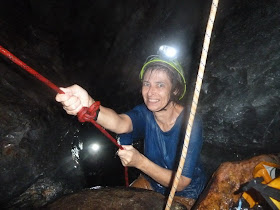During the caving expedition in Merapoh we saw a variety of cave fauna. Here are a few of the critters that we found. Frogs and toads were quite common.
These are all Phrynoides aspera
This pretty frog is Hylarana labialis
We saw cave racers in 3 caves. One had more of a yellow colour than the other two. Two were coiled up on ledges so it was not easy to get photos.
Normally crickets are common in Malaysian caves, but these caves in Merapoh had very few of the common Diestrammena crickets. This is a large species
Whip spiders (Amblypygids) were quite common.
Gua Jinjang Pelamin had quite a lot of scorpions, probably a Lychas species
The one above is eating a cockroach and the one below is eating a newly moulted spider
There were long legged centipedes, Thereuopoda
Huntsman spiders, this one is missing a leg
and this one is sitting on an egg sac
A web spider, probably Psechrus
There were very few millipedes
Of course there were bats in most of the caves. The majority were insect eating bats.
There were goat droppings in several caves (above). And in Gua Gajah Merah we saw elephant droppings -
Termite trails going around one cave entrance
and these tunnels seem to be made by ants, not termites
I saw lots of gecko eggs, but no geckoes
A (bird) nest
Outside one cave we saw bear prints in the soil
There were lots of yellow shells outside the caves, Amphidromus atricallosus perakensis (thanks to Reuben Clements for ID)
© Liz Price
No reproduction without permission
Pictorial blogs on some of the interesting caves I have visited around Southeast Asia. On some blogs I have included photos taken over the years.
Although this blog was only born in 2011, I have now included older posts from my Multiply blog which closed in March 2013. This includes articles I have written. I am now also adding news relating to caves I have a particular interest in.
See my website on Caves of Malaysia.
Pages
▼
25 September 2012
Merapoh 2012 - pt 7, Gua Hari Malaysia
We found Gua Hari Malaysia on 16th and explored it as far as the first waterfall. On the next day the Croatians started to survey it and put bolts on the waterfalls so they could be safely climbed using handlines. They also reached the end of the cave
On the 18th, the final day of the expedition, the entire team returned to the cave. Walking to the cave
The Malaysian team
Waiting to climb the first waterfall
The 2nd waterfall
The camera doesn't like the water -
We reach the water slide
Stals on a 45 degree ledge
We reach the upper entrance, the sink
The 2 smurfs
We immediately started walking upstream to see the source of the water.
It looked as if we were in an enormous wang, i.e. totally surrounded by hills, although it was difficult to see with all the trees. But then we found more large bones, so I would guess this area is not entirely surrounded by hills.
The Malaysian team before ready to re-enter the cave
We had a speedy exit through the cave, taking just 35 mins. The cave is approx 880 m long, with 5 waterfalls (2 needing a handline) and cascades.
Back at the entrance.
A great end to the Merapoh 2012 expedition.
See more on Gua Hari Malaysia.
© Liz Price
No reproduction without permission
On the 18th, the final day of the expedition, the entire team returned to the cave. Walking to the cave
The Malaysian team
Waiting to climb the first waterfall
The 2nd waterfall
The camera doesn't like the water -
We reach the water slide
Stals on a 45 degree ledge
We reach the upper entrance, the sink
The 2 smurfs
We immediately started walking upstream to see the source of the water.
It looked as if we were in an enormous wang, i.e. totally surrounded by hills, although it was difficult to see with all the trees. But then we found more large bones, so I would guess this area is not entirely surrounded by hills.
The Malaysian team before ready to re-enter the cave
We had a speedy exit through the cave, taking just 35 mins. The cave is approx 880 m long, with 5 waterfalls (2 needing a handline) and cascades.
Back at the entrance.
A great end to the Merapoh 2012 expedition.
See more on Gua Hari Malaysia.
© Liz Price
No reproduction without permission



































































